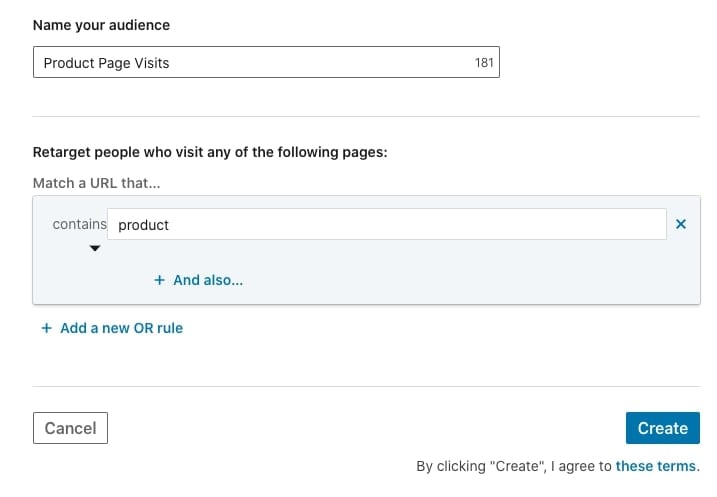Selecting the right audiences is one of the most important steps in planning a successful campaign. In most cases, at the top of the marketing funnel you need to start with broad audiences that probably don’t know your brand, products or services and nurture them through a series of relevant and useful contents to conversion phase. In this post, we will review some targeting ideas for different stages of a marketing funnel on LinkedIn Ads platform. The platform known for its strong B2B footprint, has introduced some interesting engagement-based audiences that we will talk about them too.
Top of Funnel
1. Core audiences: This is what LinkedIn is famous for. All company, job title, interests, education and demographics targeting are in this group. In order to use these options effectively, you need to have a good understanding of your customer persona and try to get close to it by mixing and matching different targeting options. But, don’t overdo it. Remember that this is very top of your funnel and you need to let your content do the talking and segmentation for you. I suggest aiming for an audience size of at least 100,000 LinkedIn members for your prospecting campaign.
Pro Tip: Use Audience Templates to save time if you need to use similar core audiences in different campaigns.
2. Lookalikes: As the name suggests, these are users who share similar attributes to the seed audience that you’re making you lookalike audience off of. Therefore, the quality of it will heavily depend on the quality of your seed audience. A few ideas for lookalike seeds on LinkedIn Ads are:
- Customer/e-mail lists
- Website visits
- Users who have engaged with your video ads
- Users who have engaged with lead gen forms
You will see this list again as there are also great options for remarketing audiences. Also, you should notice the difference in user intent among the different lookalike seed types. A custom list lookalike will probably perform better than a video viewer lookalike. For that reason, prioritize the higher quality seeds in your audience building plans and test the lower-intent lookalikes as you scale your funnel and need more audiences.
Pro Tip: You probably have noticed the option for enabling Audience Expansion when setting up your targeting. We recommend leaving this off and using lookalike audiences instead so you will be in control of what the algorithm is using to build the audience based on.
3. Third party: There are several CRMs and audience services including LinkedIn’s own Sales Navigator that allow you to go even beyond built-in targeting options. Basically you can define your audiences on a 3rd party platform and integrate it with LinkedIn Ads so they will populate and remain updated dynamically. This option comes with additional audience, platform and development costs so I only advise these when you have exhausted all the built in options and are looking to expand even more. These audiences are also very helpful with ABM strategies, when you know exactly what accounts or individuals you need to target. I suggest you read this post from Noah on our blog if you’re interested to see how this looks like for a CRM like HubSpot.
Middle and Bottom of Funnel
1. Retargeting website audiences: Under LinkedIn’s Matched Audience group, this targeting functionality allows you to retarget visitors to all or specific pages on your website. You’ll need LinkedIn’s Insights Tag (aka pixel) installed on your website so it can collect the visits information and pass it back to LinkedIn Ads. Unlike Facebook Ads, there is no way to change the timeframe for this type of audience and your only option is the default 90-days window. Make sure to use conditions and rules to define website audiences that make sense for your business. This is a great way to leverage LinkedIn Ads in a multi-channel setup where you’re driving traffic from different sources to your funnel. Some examples are:
- Visits to a product page
- Visits to contact page
- Visits to more than one page
- Visits to the homepage (as of a mid-funnel audience)
- Visits to certain blog posts or content pieces

2. Retargeting video views: A fairly new feature introduced to the platform, you can create video engagement audiences based on percentage watched. Options are 25%, 50%, 75%, and 97% watch percentages of the videos going back all the way to 365 days. I recommend testing audiences from lower engagement bands for the middle of the funnel and saving the higher intent segments (75% or 95% watch time) for the bottom of the funnel.
As of now you can only use videos from your previous campaigns as the source of this engagement-based type of audience. Hopefully some day LinkedIn will expand this to include videos from organic posts too.
3. Retargeting form engagements: Similar ro video views, you can define audiences based on user’s engagement with LinkedIn Ads popular lead forms. This allows you to create audiences based on form opens and form completions in the last 365 days.
Pro Tip: The minimum number of users that the video view or lead form engagement audiences should populate before it can be used in a campaign is 300.
Pro Tip: Use exclusions so your ads remain relevant to your audience. For example, if you’re driving traffic to a content download landing page, make sure you’re excluding visits to the thank-you page of that form in your targeting definitions so visitors who have submitted the form won’t see the ad again.
Hope this gives you a few ideas about developing audiences on LinkedIn Ads. Like everything else in digital marketing, keep testing new ideas as you scale your campaigns.




